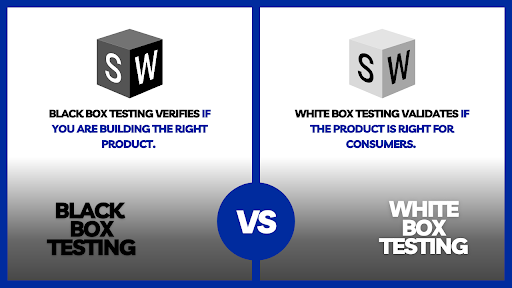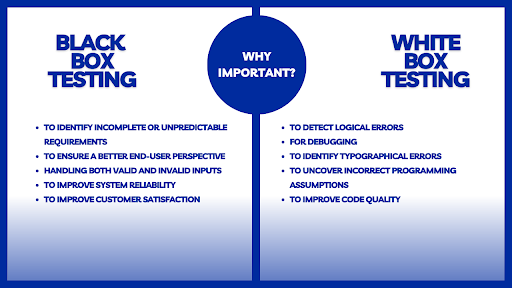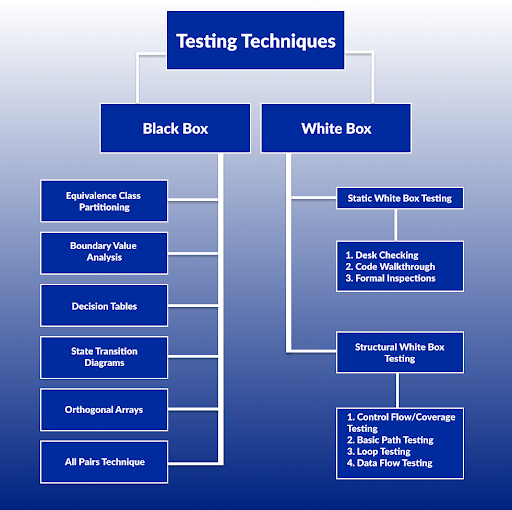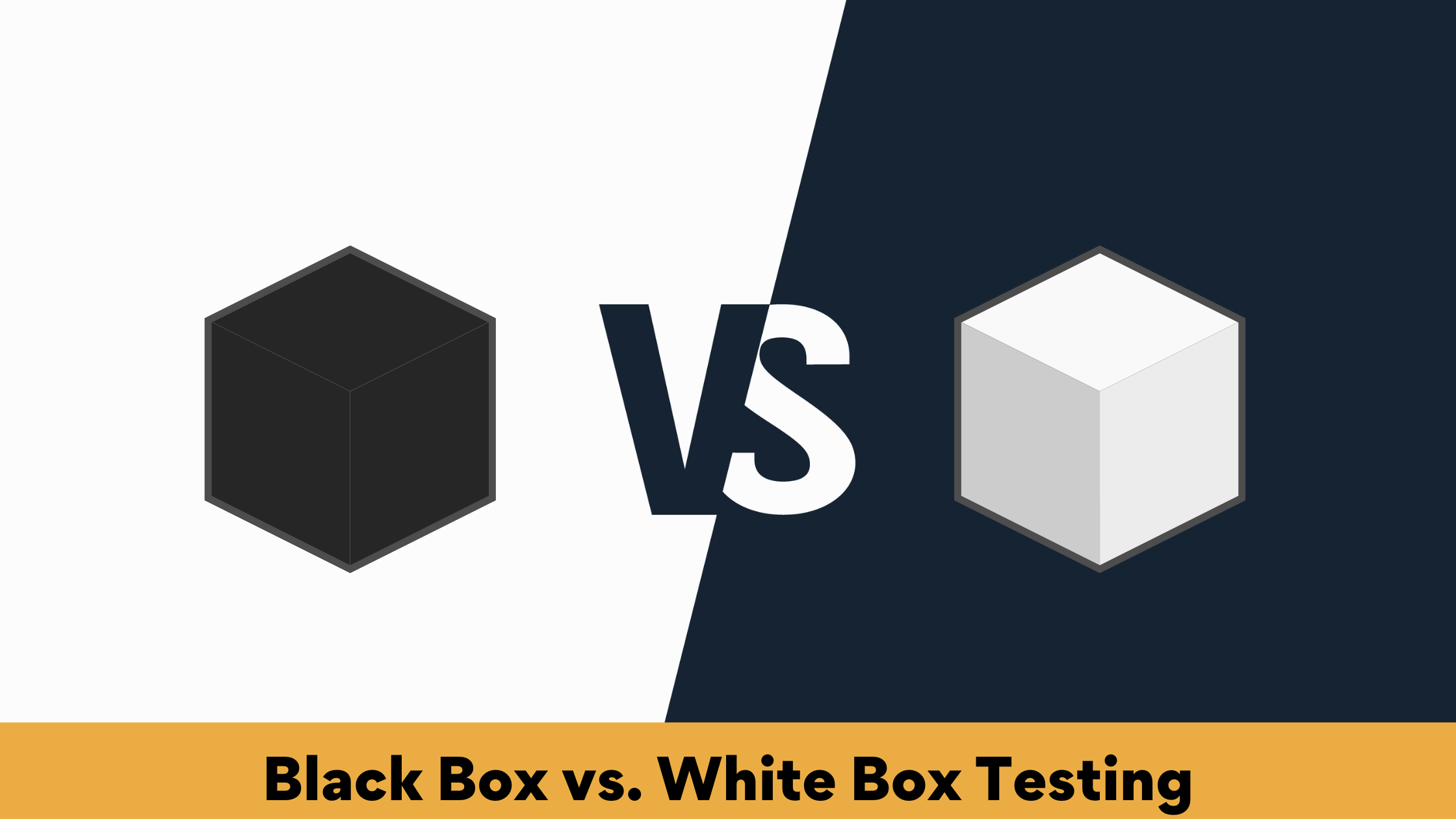Black box testing vs white box testing is the most used automated software testing technique. Software testing is good for verifying and validating the quality of software. The software testing process involves the execution of a program or system to find faults within the software. It is an expensive process and labour-intensive as well. Software testing uses more than> 50% of the software development costs.
Black box testing vs White box testing are two broadly classified testing techniques in a traditional software testing scenario.
Why do we need black box testing vs white box testing? Black box testing verifies if you are building the right product. White box testing validates if the product is right for consumers.

In this blog, we will discuss the top 10 differences between black box testing vs white box testing, including topics like why we need them, what techniques you can use and many more.
Let’s hang tight and move forward.
Black Box Testing vs White Box Testing: What are They?
Definition of Black Box Testing
Black box testing aka functional testing is a software testing technique. To use this technique, a developer designs test cases based on the product specification. In this technique, the black box software tester doesn’t have access to the internal product structure.
Black box tests aren’t concerned with the internal system and its mechanisms. A black box test focuses on the output by the system based on selected inputs and execution conditions.
Definition of White Box Testing
White box testing aka structural testing or glass box testing is a software testing technique where test cases are designed based on the internal system structure, mechanisms and code, including how different components and functions interact within the code.
A white box tester knows what the internal structure looks like. White box testing focuses on the internal implementation and design of a software system. It is primarily concerned with evaluating the control and data flow within the code, to identify and isolate any defects or bugs that may affect the system’s functionality.
Black Box Testing vs White Box Testing: Why Are They Important?

Why is Black Box Testing Important?
Black box testing is a crucial software testing technique. It validates the overall functionality of a system from an end-user perspective.
The main advantages of black box testing are listed below.
Identifying incomplete or unpredictable requirements
By testing the system based on customer requirements, black box testing can help identify any gaps or inconsistencies in the requirements, allowing the black box software testers to address these issues early in the development process.
Ensures Better End-user perspective
Black box testing is done from the perspective of a customer. It ensures that the system meets the needs of its intended users.
Handling both valid and invalid inputs
Black box testing tests the system with both valid and invalid inputs, which helps to identify any bugs or defects that may occur when the system is used in real-world scenarios.
Improving system reliability
By testing the system from an end-user perspective, black box testing improves a system’s reliability, reducing the defects or bugs causing usability issues.
Improving customer satisfaction
By identifying and addressing any bugs or defects early on, black box testing improves the overall customer satisfaction with the system, as it will have been tested and validated from their perspective.
Tip: You can contact us to hire the top 3% of software testers.
Why is White Box Testing Important
White box testing is better for identifying logical errors within a program’s code. The main advantages of white box testing are –
Detecting logical errors
White box testing is effective at uncovering logical errors within a program’s code, which can cause issues with the program’s functionality and behaviour.
Debugging
By providing an in-depth understanding of the code’s internal structure and design, white box testing can aid in the debugging process by identifying the source of issues and defects.
Identifying typographical errors
White box testing uncovers random typographical errors within the code. Upon execution of the program, it can cause unexpected errors or behaviours.
Uncovering incorrect programming assumptions
White box testing can help identify any incorrect assumptions that have been made during the programming process, which can lead to issues with the code’s functionality or behaviour.
Improving code quality
By identifying and addressing any issues within the code, white box testing can help to improve the overall quality of the code, making it more reliable and robust.
Black Box Testing vs White Box Testing: When Do You Need Them?
Black Box Testing
Black box testing is an essential component of the software development process. It begins at the early stages of a project’s life cycle.
Throughout the project, black box testing focuses on evaluating the software’s external behaviour and functionality by testing against the requirements from the end-user perspective.
To ensure the thoroughness of this testing approach, testers should be actively engaged in the requirements gathering and analysis phase, to gain a clear understanding of the customer’s needs. As the design phase progresses, testers should also be involved in creating and preparing test data and test scenarios.
This proactive approach of black box testing allows for the identification and resolution of defects early in the development cycle, ultimately improving the quality and reliability of the final product.
White Box Testing
White box testing is a method of evaluating the internal structure and design of a software system, by analyzing the control and data flow within the code.
The white box testing approach is typically applied during the lower levels of system development, such as unit, system, and integration testing, but you can still utilize it at various stages throughout the software development life cycle, including requirements analysis, design, and test case preparation.
The main advantage of white box testing is its ability to uncover logical errors and other inconsistencies within the code, which could affect the program’s functionality and behaviour.
Examining the internal design of the system allows for early identification and resolution of any issues that may impact the overall quality of the software.
Utilizing white box testing throughout the development cycle can result in a more robust, reliable and high-quality software system that meets the needs of its intended users.
Black Box Testing vs White Box Testing: What are the Testing Techniques?

Types of Black Box Testing
Here is a list of common but different types of black box testing techniques:
- Equivalence Class Partitioning
- Boundary Value Analysis
- Decision Tables
- State Transition Diagrams
- Orthogonal Arrays
- All Pairs Technique
These types of black box testing techniques are useful for identifying and isolating defects in the system under test, by focusing on specific aspects of the software’s behaviour and functionality.
Equivalence Class Partitioning helps to identify different input classes, while Boundary Value Analysis focuses on testing inputs at the edges or boundaries of a system.
Decision Tables and State Transition Diagrams are useful for testing systems with complex logic, while Orthogonal Arrays and All Pairs Technique ensure thorough testing of all possible combinations of inputs and states.
QA professionals and software testers use these techniques widely to verify the functionality and behaviour of software systems.
Types of White Box Testing
White box testing is a method of software testing that focuses on evaluating the internal structure and design of a system by analyzing the control and data flow within the code. Here are commonly used white box testing techniques that are used in the industry:
Types of Static White Box Testing
- Desk checking: Reviewing the source code manually
- Code walkthrough: A meeting where code is reviewed and discussed among developers
- Formal Inspections: A formal meeting to review code and identify defects according to a set of predefined guidelines
Types of Structural White Box Testing
Control flow/Coverage testing
This technique aims to check that the control flow of the code follows the expected path.
Basic path testing
This testing verifies that the independent code paths within a module have been tested
Loop testing
This technique aims to check that the loops in the code execute correctly and test for infinite loops, misbehaving loops and unexpected loops.
Data flow testing
Testing the movement of data through the application and identifying defects in data usage and manipulation.
These techniques identify defects and improve the overall quality of the code. They help find logical errors and defects that might affect the functionality and behaviour of the software. Developers or testers with a good understanding of the codebase perform these techniques and aim to make the software more robust, reliable and have better integrity.
Black Box Testing vs White Box Testing: The Pros and Cons
Black Box Testing: Pros and Cons
However, black-box testing also has certain limitations, including
In summary, black-box testing is the choice to validate the overall functionality of the system, but it may not cover the entire system and may not find all the defects that can exist in the software.
| Black Box Testing: Pros | Black Box Testing: Cons |
|---|---|
| Efficiency in testing large code segments. | Coverage is limited. It can perform a selected number of test scenarios. |
| A simple perception of the testing process for the tester. | Difficulty in designing test cases without any clear specifications. |
| It makes it easier to test the software from the user's perspective. | Inefficient in identifying all the potential defects in the system. |
| Quicker test case development as it focuses on the GUI. |
White Box Testing: Pros and Cons
| White Box Testing: Pros | White Box Testing: Cons |
|---|---|
| The ability to reveal errors in the hidden code by removing extra lines of code. | It requires a high level of expertise, making it a relatively expensive method. |
| It requires Insights into the internal workings of the system. Making it beneficial for debugging and troubleshooting. | The difficulty in thoroughly testing every path and corner of the code. This potentially leaves some errors undiscovered. |
| The ability to conduct risk analysis and develop a strategy for testing. | The risk of missing out on certain codes that may have been omitted in the code. |
| The ability to design a proper test plan and execute test cases to achieve maximum coverage. |
Black Box Testing vs White Box Testing: A Complete Comparison with 7 Must-Know Differences
| Black Box Testing | White Box Testing |
|---|---|
| Analyzes fundamental aspects only i.e. no proved edge of internal working | Full knowledge of internal working |
| Granularity is low | Granularity is high |
| Performed by end users and also by tester and developers (user acceptance testing) | It is performed by developers and testers |
| Testing is based on external exceptions – internal behaviour of the program is ignored | Internal are fully known |
| It is the least exhaustive and time-consuming | Potentially most exhaustive and time-consuming |
| It can test only by trial and error method | Test better: data domains and internal boundaries |
| Not suited for algorithm testing | They are well-suited for algorithm testing (suited for all) |
Conclusion
Software testing is an essential step to ensures that a program meets its specified requirements and can be safely implemented in a business environment.
Between black box testing vs white box testing, black box testing is focused on evaluating the program’s external behaviour, while white box testing delves into the internal structure of the code. Both types of testing play a crucial role in identifying and addressing defects in a program, and ultimately delivering a quality product to the end user.
A crucial well-rounded testing strategy helps you to evaluate a program thoroughly, identify the defects, and resolve them all. You must include black box testing and white box testing in your software testing strategy. Software testing techniques and approaches are evolving to match the current technology trends making it beneficial to remain updated and lookout for new and innovative ways to improve the testing process.





